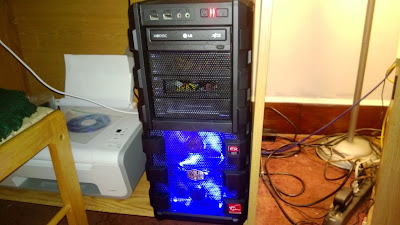Positive vs Negative Pressure PC Case Cooling
Positive VS Negative pressure.....this is a debate that has raged among PC system builders for a very long time, and a debate not easily answered. Today, I will "Attempt" to answer this question. Attempt being the key word here.
Before we dive into this discussion, I just want to point out that positive and negative pressure is a term that gets thrown around a lot in discussions, but most computer cases you find today on the market for gamers have so many holes, vents, and meshes on then that positive or negative pressure is not the most accurate way to describe them.
When speaking of Positive Pressure and Negative Pressure, I am referring to the following:
Positive Pressure: having more intake fans or the intake fans having a higher CFM then the exhaust fans.
Negative Pressure: Having more exhaust fans or the exhaust fans having a higher CFM then the intake fans.
So which one do "I personally" think is better? Honestly, I think Negative Pressure (Having more exhaust/exhaust CFM then intake) is better in "most scenarios" unless your PC case is specifically designed for more intake then exhaust.
Negative Pressure is better because the single most important thing in PC cooling is heat. the faster you can expel heat out of your case, the cooler your components will run. Also, having more exhaust then then intake means all the holes, meshes, etc on your case will be used as a conduit to suck in cooler air. This will not only lead to cooler components, but also lower ambient case temps most of the time. I have seen PC cases with 1 exhaust fan in the back, and no intakes run cooler then a larger case with two intakes and an exhaust sitting side by side.
I also feel having more exhaust then intake is more desirable because it more forgiving and has larger room for error. The favoring of more exhaust over intake means its less likely you will have any "dead spots" in your case where the air is warmer because air flow may not be good in that one area. When having more intake then exhaust, hot air stays inside the case near your components longer then it would with more exhaust, this leads to higher temps.
Now I do want to point out, that having more exhaust then intake will mean you will get "some" extra dust in your case in comparison to a case with more intake then exhaust. It has been my experience though that its not a drastic difference. Positive or Negative, your still going to have to clean out your PC every so often with compressed air, or another method of your choice.
Tom's Hardware wrote a very good article on this two years ago, that I still think applies today.
It really comes down to dust vs cooling. If having to clean your case slightly more often doesn't sound like your thing, then go with positive pressure. If the lowest temps are the most important thing for you, and your willing to clean your case slightly more often, then go with negative pressure. I don't think you can go wrong either way, but negative would seem to favor overclockers due to having overall lower temps.
Disclaimer: I am not responsible for anything that may happen to your PC when changing settings or changing registry values. If you choose to make changes, you do so at your own risk.. You are solely responsible for any damage to your computer , data, or other hardware due to user error, inadequate cooling, too high of voltages, incorrect software settings, and any other factors. Please remember to back up your computer before attempting this. If overclocking, Do not Overclock on the stock AMD or Intel CPU Heatsink and fans. Use Aftermarket cooling heat sinks of sufficient TDP or water cooling to ensure best chance of not having premature hardware failure. As always, remember to backup your data before attempting any change. I am not responsible for data loss or damage of any kind.





